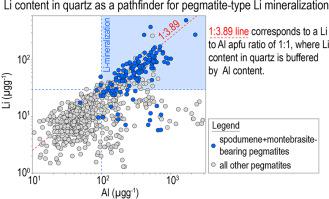Chemical Geology ( IF 3.9 ) Pub Date : 2021-08-27 , DOI: 10.1016/j.chemgeo.2021.120507 Axel Müller 1, 2 , William Keyser 1 , William B. Simmons 3 , Karen Webber 3 , Michael Wise 4 , Hartmut Beurlen 5 , Idoia Garate-Olave 6 , Encarnación Roda-Robles 6 , Miguel Ángel Galliski 7

|
Quartz from 254 pegmatites representing eight pegmatite fields and provinces worldwide was investigated by laser-ablation inductively-coupled plasma mass spectrometry (LA-ICP-MS) to determine concentrations of trace elements Al, Ti, Li, Ge, B, Be, Rb, Na, K, Ca, P, Ga, Sb, Zn and U. A total of 271 new analyses combined with 535 published LA-ICP-MS quartz chemistry data were evaluated with binary and ternary trace element discrimination plots and principal component analysis (PCA). The classifications applied for discrimination of pegmatite types include the widely applied NYF(Nb-Y-F) - LCT(Li-Cs-Ta) classification and the new RMG (pegmatites derived from residual melts of granite magmatism) - DPA (pegmatites as direct products of anatexis) grouping. Pegmatites of both classifications can be well distinguished via Al-Ti, Al-Li and Al/Ti-Ge/Ti binary trace element plots and the Ti - Al/10 - 10*Ge ternary diagram. PCA applied to Al, Li, Ti, Be, B, Ge and Rb contents in quartz allowed to further distinguish between anatectic DPA-1 (Li-enriched DPA) and granite-pluton-derived RMG-1 (Li-enriched RMG) pegmatites. Some pegmatite fields and provinces (Hagendorf-Pleystein, Oxford County) are distinguishable by region-specific Li, Ge and Al contents. The results imply that the chemistry of pegmatite quartz is mainly controlled by the origin (source rock chemistry) of pegmatite melts and, to a much lesser extent, by the geodynamic setting of the pegmatite fields and provinces. Chemically primitive NYF and DPA-2 type pegmatites contain quartz with the lowest total trace-element contents and lowest internal-pegmatite trace-element variation, making it potentially suitable for high-tech application. Pegmatite quartz containing >30 μgg-1 Li and >100 μgg-1 Al is strongly indicative of economic spodumene/montebrasite mineralization and, thus, serves as a strong Li-mineralization pathfinder mineral. Quartz with >5 μgg-1 B may be a potential indicator for gem-quality tourmaline mineralization.
中文翻译:

花岗岩伟晶岩的石英化学:对分类、成因和勘探的启示
通过激光烧蚀电感耦合等离子体质谱法 (LA-ICP-MS) 研究了来自代表全球八个伟晶岩领域和省份的 254 块伟晶岩的石英,以确定痕量元素 Al、Ti、Li、Ge、B、Be、Rb、 Na、K、Ca、P、Ga、Sb、Zn 和 U。 使用二元和三元微量元素判别图和主成分分析 (PCA )。用于区分伟晶岩类型的分类包括广泛应用的 NYF(Nb-YF) - LCT(Li-Cs-Ta) 分类和新的 RMG(花岗岩岩浆残余熔体产生的伟晶岩)- DPA(伟晶岩作为anatexis) 分组。两种类别的伟晶岩都可以通过 Al-Ti 很好地区分,Al-Li 和 Al/Ti-Ge/Ti 二元微量元素图以及 Ti - Al/10 - 10*Ge 三元图。PCA 应用于石英中的 Al、Li、Ti、Be、B、Ge 和 Rb 含量,可以进一步区分深熔 DPA-1(富锂 DPA)和花岗岩-岩体衍生的 RMG-1(富锂 RMG)伟晶岩. 一些伟晶岩领域和省份(Hagendorf-Pleystein,牛津县)可通过特定区域的 Li、Ge 和 Al 含量进行区分。结果表明,伟晶岩石英的化学主要受伟晶岩熔体的成因(烃源岩化学)控制,在较小程度上受伟晶岩领域和省份的地球动力学环境控制。化学原始 NYF 和 DPA-2 型伟晶岩含有石英,其总微量元素含量最低,伟晶岩内部微量元素变化最低,使其有可能适用于高科技应用。伟晶岩石英含量 >30 μgg-1 Li 和 >100 μgg -1 Al 强烈表明锂辉石 / montebrasite 矿化的经济性,因此,可作为强大的锂矿化探路者矿物。含有 >5 μgg -1 B 的石英可能是宝石级碧玺矿化的潜在指标。


























 京公网安备 11010802027423号
京公网安备 11010802027423号